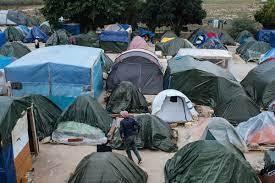The Ghetto Is On Fire! The Struggle Of Migrant Agricultural Workers For Autonomy In Sicily
Experiences from the field: This new section on our blog is dedicated to the experiences of those on the ground, activists, community advocates and experts-by-experience. This new ongoing series has been organised by Francesca Esposito and Andriani Fili, as part of their continuing work in expanding the connections between Border Criminologies and community engagement and activism, and in using the Border Criminologies platform to amplify the voices and experiences of those at the forefront of struggles against border violence. These voices, and the meaningful insights they provide, are in fact often overlooked in mainstream academic discourses. This ongoing series attempts to fill this gap. Do get in touch with us if you want to contribute.
Posted:
Time to read:
Guest post by activists from Contadinazioni-Fuorimercato. Contadinazioni and Fuorimercato are an association and a trade union supporting migrant workers employed in the agro-industrial sector.

Campobello Di Mazara, Sicily, Italy. October 2016. Image by Francesco Bellina / Cesura
https://francescobellina.photoshelter.com/portfolio/G00005s1WXuqLA9Q/I00005IL7J9WwfmA
Every year, more than a thousand of foreign workers differentially included in Italy gather together in the small town of Campobello di Mazara, in south-west Sicily, to harvest olives that will then be sold by the producers to the great distribution companies. Many of them have short-term documents, some have long-term ones, and many others do not have any, depending on where they are from and what their lives have been in Europe.
The majority of them are from Senegal, Gambia, Mali, Ivory Coast, Ciad, but there are also people from many other countries. The people that arrive in Campobello are agricultural workers, and their movements around the Italian countryside define the map of modern forms of exploitation and resistance in the Italian agro-industrial sector: from Sicily to Calabria and then to Puglia or Campania, but also in the northern part of the country. A map of labour mobility that is parallel, and at the same time overlapping, with the trajectories of people on the move, especially the ones arriving in Europe via the Central Mediterranean.
On the night of the 30th of September 2021, the ghetto where these migrant workers used to live, in a former concrete factory, burnt for hours in front of hundreds of people who slowly and carefully built it and organized it over the past three years. A man, Omar Baldeh, tragically died in the fire.
The ghetto was built in 2017 after the local and international - private, humanitarian and public - institutions evicted the previous camp and built an institutional “tent city” in Fontane d’oro - a former oil mill confiscated by the state to the mafia. The ghetto was run by the Red Cross and only people with regular documents could enter in there. It is in this context that the ghetto in the former Calcestruzzi factory - now burnt - was built: for many workers - with and without documents - autonomy and collective self-organization are more important than top-down emergency solutions which usually offer precarious living-spaces where people cannot cook, have strict schedules and, most importantly, are divided between those who have documents and those who do not.
And, after the ghetto was destroyed by the fire, one of their friends died and the spectre of an emergency solution came up on the morning of the 30th, migrant workers began a road blockade. “They want to put us in a hotel”, some of them said, and immediately they blocked the road saying, “We don’t want any [institutional] help. We want just two things: not to go in the hotel, and we want to go instead where we were in the past years. If you can’t listen to us, we will block the road!” And so it was. While local and regional institutions remained silent, the organized workers - part of our trade union Fuorimercato, which immediately launched a crowdfunding to support the people that lived in the ghetto - started a demonstration which arrived in Fontane d’oro, where the dismantled Red Cross camp used to be. It was in this contested and conflictual place that the migrant workers started building their new camp, in the ashes of the previous one.
In the next four days, from the 1st to the 5th of October, the migrant workers resisted an eviction attempt by the police, an eviction that was supported also by many humanitarian organizations operating in the area, which argued that this “occupation is not the best for workers”. The reason for this eviction was - officially - that a new, emergency Red Cross camp would be built to host two-hundred people, much less than the people in Campobello at the moment of the fire. This is crucial, as workers very clearly stated “we don’t want the Red Cross, we want our autonomy, we want to stay together here”. While all the white people involved in this story couldn’t understand why they didn’t want the Red Cross camp, the workers challenged and contested the humanitarian paradigm of “we are going to save you” on which many humanitarian organizations rely, as well as its intimate connection with the securitarian paradigm adopted by the police. This same humanitarian-security paradigm indeed, legitimated their eviction in the past, while also aiming to differentiate them according to their documents. Who would take advantage of such a situation? Employers, of course, which always benefit from a fragmented, precarious and racialised workforce.
In opposition to all of this, migrant workers showed a strong ethnic and inter-ethnic solidarity. The resistance to the eviction was made concrete by practices of resistance. On the one hand, using the solidarity fund provided by Fuorimercato, workers in Fontane d’oro bought tents, mattresses and materials with which they built the new camp. In this process, they organized lists of people and needs, so that everyone could have access to a tent, a blanket and a mattress. In just a couple of days, the self-organized restaurants began to be operative in the new camp. On the other hand, as many people continued to remain in the burnt ghetto - because they didn’t want to be exposed to the media and the police -, the people living in Fontane d’oro began to bring food, clothes and other supplies coming from donations to the old ghetto, to support those who could not be in the forefront of this fight, but had still been affected by the fire.
While the migrant people in Campobello are now working with a pool of lawyers to have access to the documents that ended up being burnt in the fire - and they are also trying to push a “document for all” political agenda -, they have also decided that the “House of Mutual Help of daily labourers in agriculture”, which had been inaugurated in Campobello the day after the fire, will be named after Omar Baldeh (Casa del Mutuo Soccorso dei braccianti di Fuorimercato Omar Baldeh), the Guinean man who died in the fire. It is from here that their fight for a place that they can self-manage and self-organize - along with the struggle for decent working conditions - will go ahead.
Any comments about this post? Get in touch with us! Send us an email, or post a comment here or on Facebook. You can also tweet us.
__________
How to cite this blog post (Harvard style)
Activists from Contadinazioni-Fuorimercato (2021). FThe Ghetto Is On Fire! The Struggle Of Migrant Agricultural Workers For Autonomy In Sicily. Available at: https://www.law.ox.ac.uk/research-subject-groups/centre-criminology/centreborder-criminologies/blog/2022/01/ghetto-fire [date]
Keywords:
Share:








